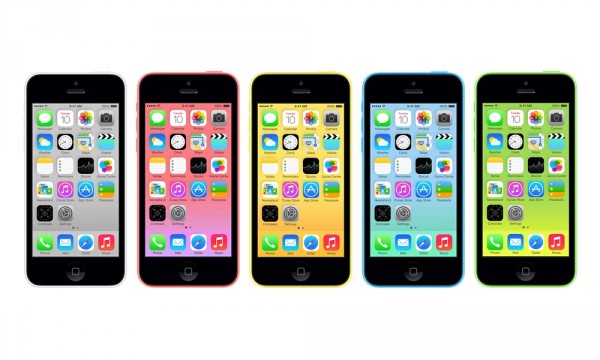With iPhone 5C Apple takes a stab at the mid-range smartphone market

Apple changed the smartphone market dramatically with the original iPhone, which launched in mid-2007. The company took the world by surprise as it reenvisioned the basic smartphone concept by forgoing the (typical) unintuitive user interfaces and adopting a simpler, hardware and software, design instead. The iPhone had turned Apple into the top smartphone vendor, a title which the Cupertino, Calif.-based corporation can no longer claim today. Why?
The short answer is "Android". The long one is a bit more complicated. Apple began changing the smartphone market in 2007, but the smartphone market changed as well since then. The iPhone was and still is a flagship product, a high-end handset with the price to reflect it. Consumers, however, have been slowly moving away from that price range and type of device to cheaper, mid-range and low-end products. According to an IDC report from June, the smartphone average selling price (ASP) dropped from $443 in 2011 to $372 in the first half of 2013, and is expected to drop even further, to $309 by 2017. That is a price-bracket that Apple could not tap into, as it had no product to fight with. The iPhone 5C, that the company just unveiled during a special event, is designed to change that.
The drop in smartphone ASP coupled with the iPhone 5C announcement portray an Apple that is committed to reclaiming its lost crown, as top smartphone vendor, by doing something concrete about it, something that's albeit indicative of a reactive strategy instead of a proactive one as was the case with the original iPhone, in 2007. The iPhone 5C is to the iPhone what the iPad Mini is to the iPad -- a downsized iteration, only this time around, unlike the smaller tablet, this doesn't refer to the actual size of the handset.
The iPhone 5C is about the same size (124.4 x 59.2 x 8.97 mm and 132 grams) as the new iPhone 5S, that my colleague Mark Wilson covered here. But, being a mid-range smartphone, something had to give. Here's what you need to know in respect to the iPhone 5C corner cutting. Apple's new, entry-level smartphone does away with the all-aluminum back that the iPhone 5 introduced, last year. Instead, the company is using a plastic/polycarbonate back (with a steel frame, which acts as an antenna), that we almost forgot about since the iPhone 3GS days.
The plastic back, however, brings along with it something that has always been missing from the iPhone lineup -- a wider color palette. The iPhone 5C will be available in blue, green, pink, yellow and white. The first four were not previously available, while the last one was (and continues to be). Apple likely hopes that the extended color palette will help the iPhone 5C reach a new userbase, who isn't afraid to experiment with non-traditional colors (black and white) and is looking for more differentiation options than a third-party case can provide (although Apple now offers that too, for $29 a pot, in various colors, featuring circular holes on the lower side). It's something similar to what Nokia has been doing with its Windows Phone lineup, since launch, but without the back cover-swapping.
With the iPhone 5C, Apple also cut corners in the camera and processor departments by reusing existing hardware. The smartphone offers an 8 MP "iSight" unit and relies on an A6 chip to power all the tasks, both of the same type as in the iPhone 5. It's by no means a budget-oriented approach. Instead it points out that Apple's definition of budget smartphone isn't the same as with other makers (it's budget, but at a premium). The screen gets a pass, as it's a 4-inch "Retina" LCD panel, with the same resolution of 1,136 by 640 as in the iPhone 5. On the front, there's a FaceTime HD camera (720p video recording).
Connectivity-wise, the iPhone 5C features 4G LTE mobile network support; Wi-Fi 802.11 a/b/g/n (no "ac" support) and Bluetooth 4.0 as the main highlights. There's nothing really out of the ordinary in this department, as these are all features that we have already seen in other smartphones. The 4G LTE support, however, is instrumental in ensuring proper mobile operator backing with latest-generation networks (4G LTE started to roll out in Europe, for instance, since last fall and is expected to expand in a larger number of markets in the near future).
The iPhone 5C, as you might suspect, runs iOS 7. The latest iteration of the operating system will be launched on September 18, eight days down the road from now. You can read about what's new here. My colleague Wayne Williams has covered everything that you need to know.
For the iPhone 5C Apple quotes up to: 10 hours of talk time using 3G networks, 250 hours of standby time, 10 hours of 4G LTE or Wi-Fi web browsing (eight hours on 3G networks), 10 hours of video playback and 40 hours of music playback.
Being a mid-range smartphone, the pricing scheme of the new iPhone 5C reflects that. The smartphone will be available, in the US, at AT&T, Sprint and Verizon for $99 alongside a two-year contract for the 16 GB version, and $199, still with the same type of mobile operator agreement, for the 32 GB model. The base price is half of what local mobile operators charge for the iPhone 5 (and for the iPhone 5S too, once it's available). The launch day has yet to be revealed. Pre-orders kick off on September 13. Unlocked prices are $549 for the 16 GB version and $649 for the 32 GB model.
